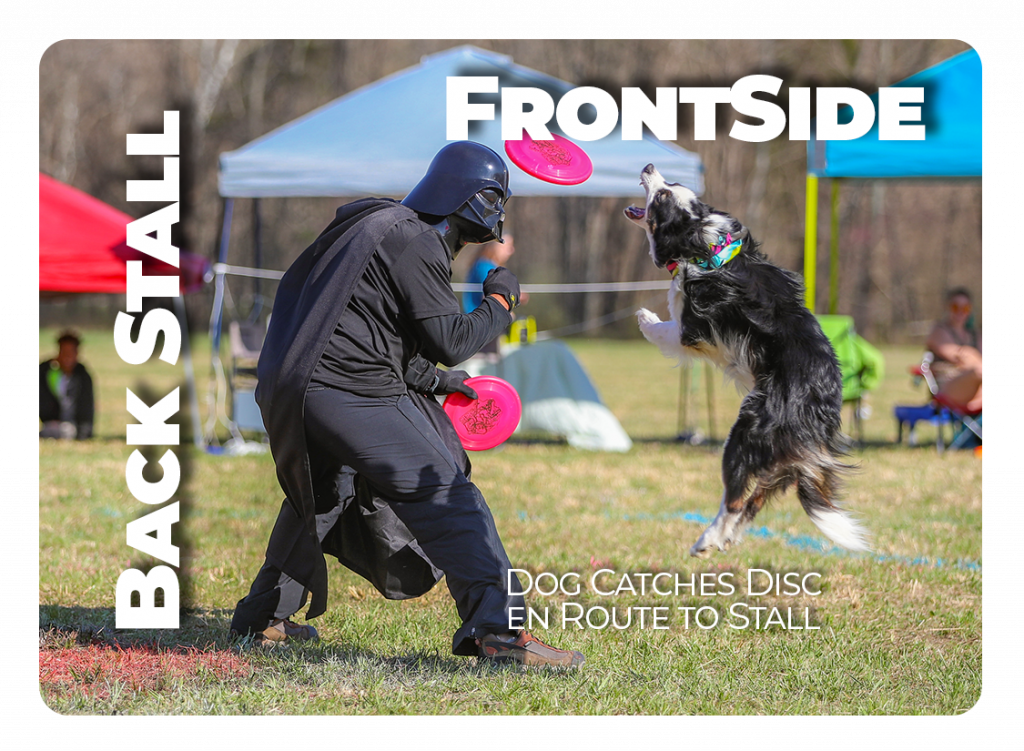
Ron Watson | FrontSide Back Stall
Dog Catches Disc en Route to Back Stall

the FrontSide Back Stall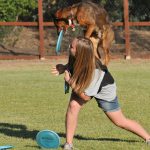 A Stall happens when your dog leaps up and stays on a part of your body. Stalls are usually named by the part of your body they happen on. If your dog leaps... More has the dog catching the disc on the way to the back. here you can see Eppie leaving the ground for both the Target and my back on the run which demonstrates Canine, Handler, and Team skills.
A Stall happens when your dog leaps up and stays on a part of your body. Stalls are usually named by the part of your body they happen on. If your dog leaps... More has the dog catching the disc on the way to the back. here you can see Eppie leaving the ground for both the Target and my back on the run which demonstrates Canine, Handler, and Team skills.
Keys to the Trick:
- Strong Pedestal/Stall Behavior
- Verbal Cue
- Solid Low High Trigger
- Sharp Stall
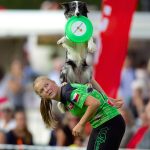 A Stall has the dog leaping up and chilling out on the handler’s back. Stalls are great for showmanship and for presenting a dog to the crowd. They create a dramatic or emotive... More PositionIn the Play+ philosophy, "Position" is the final stage within the "Next" phase of a Cycle of Play. It acts as a pivotal link between the "Next" phase and a new "Now" phase. More
A Stall has the dog leaping up and chilling out on the handler’s back. Stalls are great for showmanship and for presenting a dog to the crowd. They create a dramatic or emotive... More PositionIn the Play+ philosophy, "Position" is the final stage within the "Next" phase of a Cycle of Play. It acts as a pivotal link between the "Next" phase and a new "Now" phase. More - Release
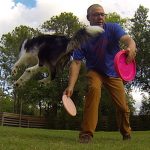 Release has many meanings in disc. Throws and throw variations can be referred to as releases. Sometimes you talk about the dog releasing something, the toy, or the environment, as in to stop... More From Stall
Release has many meanings in disc. Throws and throw variations can be referred to as releases. Sometimes you talk about the dog releasing something, the toy, or the environment, as in to stop... More From Stall - Flatwork
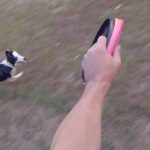 Flatwork is the stuff that happens between the catches. How the team moves and transitions, often without the disc, is flatwork. Flatwork concepts in disc dog are taken from the agility and herding... More and Understanding of Pressure
Flatwork is the stuff that happens between the catches. How the team moves and transitions, often without the disc, is flatwork. Flatwork concepts in disc dog are taken from the agility and herding... More and Understanding of Pressure Pressure comes in many forms in dog training. Positional Pressure, Performance Pressure, Environmental Pressure, the Plane of the handler’s body. Pressure is a fact. How you wield it or leverage it is up... More
Pressure comes in many forms in dog training. Positional Pressure, Performance Pressure, Environmental Pressure, the Plane of the handler’s body. Pressure is a fact. How you wield it or leverage it is up... More
Bullet Proof Stall/Pedestal Behavior
create Desire before Duration. the dog should need to be up on the pedestal. create Desire to stall and you can leverage it towards keeping the dog there. a strong desire by the dog to do the pedestal is key.
This just can’t be stressed enough. The Stall has to be money. Your duration behavior has to be money. The End. The dog needs to have as strong a desire to stick the Stall as they have get the disc.
You want your dog to leap for the disc and to land on your back like a cat, ready to rock and wagging that Epic little tail…
This trick can be done without a strong Pedestal/Stall behavior, or a desire to do them, but it will be an ugly jerky kind of thing that has the dog splatting on your back and it will likely not happen on the run.
Verbal Cue and Neutral Position Let the Dog Wonder When…?
verbal THEN physical when it comes to cuing. with the FrontSide Stall it’s a great idea if the dog wonders when and even if the Trigger is gonna happen. give your verbal cue for Stall and chill in neutral until you Trigger.
I want the dog to know that the Stall is happening from quite a ways away, particularly if it’s happening on the run. I give the verbal at 10-15 yards pretty frequently and I hold a neutral (or slightly antagonistic) position, a “holding my ground” kind of thing. And I allow the dog to come in and start to look for the Trigger.
I find that having the dog actively watching for the Trigger to happen is very helpful in this skill. The dog can’t push you into the skill if there is a question as to whether or not the Stall is going to happen.
Low High Trigger Understood by Dog | Handler | Team
timing is really tight in the FrontSide Back Stall. it’s a short toss to a tiny spot Spot is a “go to a place”, or “go to a mat” behavior. This means that the dog seeks out and performs a duration behavior on a spot of the handler’s choosing. A... More in Space and Time. a tight response to the Trigger by the dog is key to respond to the Target and the handler’s back. the dog cannot lead this skill.
Spot is a “go to a place”, or “go to a mat” behavior. This means that the dog seeks out and performs a duration behavior on a spot of the handler’s choosing. A... More in Space and Time. a tight response to the Trigger by the dog is key to respond to the Target and the handler’s back. the dog cannot lead this skill.
The Trigger in the Low high Toss is the disc hitting a horizontal position. Ideally this happens with a sharp, clean bouncing action after a short drop. This creates a short and clear Trigger that prevents the dog from deciding to GO! until the disc is essentially being released.
If the handler drops the disc down and the dog goes before it goes horizontal, don’t throw. The dog has jumped the Trigger and has found something earlier that predicts it. If you throw it after the dog goes you no longer Trigger or control the start of the trick. Your dog will be splatting on your back if you’re lucky.
When the Low High is tight, the disc bounces to horizontal at the bottom of the toss and then Eppie breaks his stride and collects for the leaping catch knowing
Obstacle is Trigger for Stall, Right? So Do It!
the presentation of the obstacle is a natural Trigger for Vaults and Stalls. in a regular Back Stall the Trigger for collection to leap is the start of obstacle presentation. finish your throw and shift to Stall position swiftly.
Your dog knows there is a stall coming and has broken stride for the throw. When the throw comes out, you Gotta GO! Read In Play+, "Read Release" refers to the handler's observation and interpretation of the dog's behavior following the completion of an action or behavior. More that throw as it comes out of your hands and move to where your dog is going to be for the Stall. You’ve got to be a little flexible to account for your !@#$ty tosses and small variations in timing and placement.
In Play+, "Read Release" refers to the handler's observation and interpretation of the dog's behavior following the completion of an action or behavior. More that throw as it comes out of your hands and move to where your dog is going to be for the Stall. You’ve got to be a little flexible to account for your !@#$ty tosses and small variations in timing and placement.
The earlier your dog sees the obstacle the more thoughtful and purposeful the leap up the the Stall can be. It’s a simple as that. Throw – Stall – Boom – Pow!
Release from Stall – Mission Critical!
so, exactly HOW is the release from the Stall mission critical to this skill? if the dog knows that the point of the Stall is to be released on Cue, then you just have to stick the landing. this BackChain is critical to this Stall.
This might be a bit surprising, but this piece of the puzzle is like the keystone of the entire behavior. The burning desire to get Off makes it important to get on properly. The desire to get Off on cue and an understanding that nothing is going to happen until that Off cue is complied with means that if a miss happens, either the disc or the Stall, the dog will self correct, immediately.
Not only will the dog self correct immediately after an error, the dog will not want to miss because missing means I might have to get off and go get the disc or I might not be able to go down and get that disc… regardless of the reason, a missed catch can get in the way of an efficient and easy “Off”.
I like to allow my dog to fetch up a missed disc and leap up to the Stall, I like that he knows the disc needs to be up there too – multiple work with Drop and Give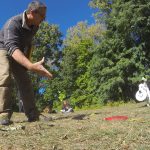 The Give is a retrieve to the hand. A cued Give is a foundational skill that is not super useful in the actual performance of disc dog freestyle, and has huge applications for... More on a Pedestal is all but required for this skill and has become a foundational skill for me and my dogs over the last few years… just sayin… 😉
The Give is a retrieve to the hand. A cued Give is a foundational skill that is not super useful in the actual performance of disc dog freestyle, and has huge applications for... More on a Pedestal is all but required for this skill and has become a foundational skill for me and my dogs over the last few years… just sayin… 😉
Hold Your Ground and Leverage Pressure
apply subtle positional pressure on the dog, perhaps with a Pose in BSP (Basic Standing Position). let the dog stalk his or her way in. this antagonistic pressure combined with a clear Trigger creates a sooth successful pace.
I like to slightly declare my position or direction against the dog’s, if he’s coming in clockwise, I’m applying a bit of counter clock pressure. I hold this slight antagonistic pressure until the Trigger.
If I feel like the dog is approaching too hot or too fast or is somehow being too aggressive, I won’t make a throw at all. Just hold your ground and do nothing. It’s an amazing lesson for the dog and it goes a long way towards strengthening and proofing your Trigger, and creating questions in your dog’s mind as to “When is that Trigger gonna happen?”



